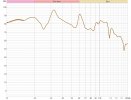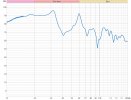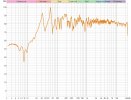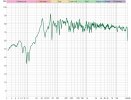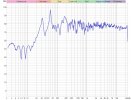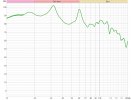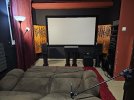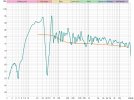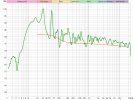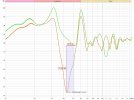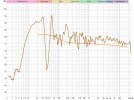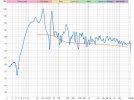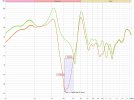Hi Everyone !
I need an advice for the my stereo setup.
I am using a 7.2.4 system that is used for HC and music in a dedicated room. Rough dimentions : 520 cm x 320 cm. Ceiling 260 cm.
The stereo path of my system :
DAC: Denafrips ARES 12TH
Pre/Pro: Emotiva XMC-2
Power: Emotiva XPA-2
Speakers : KEF R3
Subwoofers : 2 x SVS SB-2000 Pro combined with MiniDSP 2x4HD
HTPC with local lossless collection streamed to the DAC exclusively through JRiver with USB connection.
In the past I was using the automatic room correction for both the music and the HC with some tweaks here and there. Audyssey (Denon), ARC (Anthem) and Dirac since Emotiva XMC-1.
Recently I have added the second sub with minidsp and some pressure acoustic treatment.
I understand that nowadays with the available tools (hardware and knowledge) one may achieve pretty good results manually measuring and building the RC filters.
Following the outstanding guides of Serkan ( OCA ) I would like to try to make a best possible digital filters correction manually instead of the Dirac for the music listening.
I have some knowledge and experience with REW over the years and the calibrated Umik-1 mic I have purchased in the past from the Cross Spectrum.
The MLP for the music is a static single position ( focused ).
I can of course make my measurements, time align and create the IIR filers with REW and upload it to the XMC-2. This part is what I am familiar with. And maybe I will achive even better customized resule in FEQ that Dirac, I am convinced that Dirac will do a better job treating the phase.
The OCA guides include several ways to create both the IIR and the FIR filters.
The FIR filters are a learning curve for me. I am trying to get my head over the Virtual Bass Array, Phase inversion, Convolution filters among other interesting phase related tools.
Since the guides are not structured between each other, please advice what would be the best practice for me to go with in order to combine the FIR with IIR filters ?
1. Should I measure and EQ with IIR filters first applying in XMC-2 ( full range - subs + L / subs + R ) and afterwards measure & create the convolution filter for the JRiver ? - probably not the optimal order.
2. Should I first create the convolution filter for full range - subs + L / subs + R, apply it in JRiver and then run the measurements with the pink noise/sweeps files generated by REW through the JRiver for the IIR filters EQ in order to apply them into the XMC-2 ? - probably better result.
3. Or should I split the FIR and IIR filters between the subs and the speakers ?
In other words - first create the FIR filters for each of the subwoofers and apply in the minidsp ? Then create the convolution filter for the speakers response only (no subs) for JRiver ? Then IIR EQ for the subs only to apply in minidsp and different IIR EQ for the L and R speakers only, applied in the XMC-2 DSP ? With both EQed responses crossed properly according to the Harman curve ?
As you may understand I am a bit lost. As a matter of fact I love what Dirac does to the room correction, but I do not like the black box implementation with no details of the changes made besides the impulse delay. Dirac treats the phase pretty nice though. Yet I want to try the manual path for thee stereo I never did before for the enthusiasm or maybe for even a better result than Dirac...
What do you think ?
I need an advice for the my stereo setup.
I am using a 7.2.4 system that is used for HC and music in a dedicated room. Rough dimentions : 520 cm x 320 cm. Ceiling 260 cm.
The stereo path of my system :
DAC: Denafrips ARES 12TH
Pre/Pro: Emotiva XMC-2
Power: Emotiva XPA-2
Speakers : KEF R3
Subwoofers : 2 x SVS SB-2000 Pro combined with MiniDSP 2x4HD
HTPC with local lossless collection streamed to the DAC exclusively through JRiver with USB connection.
In the past I was using the automatic room correction for both the music and the HC with some tweaks here and there. Audyssey (Denon), ARC (Anthem) and Dirac since Emotiva XMC-1.
Recently I have added the second sub with minidsp and some pressure acoustic treatment.
I understand that nowadays with the available tools (hardware and knowledge) one may achieve pretty good results manually measuring and building the RC filters.
Following the outstanding guides of Serkan ( OCA ) I would like to try to make a best possible digital filters correction manually instead of the Dirac for the music listening.
I have some knowledge and experience with REW over the years and the calibrated Umik-1 mic I have purchased in the past from the Cross Spectrum.
The MLP for the music is a static single position ( focused ).
I can of course make my measurements, time align and create the IIR filers with REW and upload it to the XMC-2. This part is what I am familiar with. And maybe I will achive even better customized resule in FEQ that Dirac, I am convinced that Dirac will do a better job treating the phase.
The OCA guides include several ways to create both the IIR and the FIR filters.
The FIR filters are a learning curve for me. I am trying to get my head over the Virtual Bass Array, Phase inversion, Convolution filters among other interesting phase related tools.
Since the guides are not structured between each other, please advice what would be the best practice for me to go with in order to combine the FIR with IIR filters ?
1. Should I measure and EQ with IIR filters first applying in XMC-2 ( full range - subs + L / subs + R ) and afterwards measure & create the convolution filter for the JRiver ? - probably not the optimal order.
2. Should I first create the convolution filter for full range - subs + L / subs + R, apply it in JRiver and then run the measurements with the pink noise/sweeps files generated by REW through the JRiver for the IIR filters EQ in order to apply them into the XMC-2 ? - probably better result.
3. Or should I split the FIR and IIR filters between the subs and the speakers ?
In other words - first create the FIR filters for each of the subwoofers and apply in the minidsp ? Then create the convolution filter for the speakers response only (no subs) for JRiver ? Then IIR EQ for the subs only to apply in minidsp and different IIR EQ for the L and R speakers only, applied in the XMC-2 DSP ? With both EQed responses crossed properly according to the Harman curve ?
As you may understand I am a bit lost. As a matter of fact I love what Dirac does to the room correction, but I do not like the black box implementation with no details of the changes made besides the impulse delay. Dirac treats the phase pretty nice though. Yet I want to try the manual path for thee stereo I never did before for the enthusiasm or maybe for even a better result than Dirac...
What do you think ?
Last edited:

